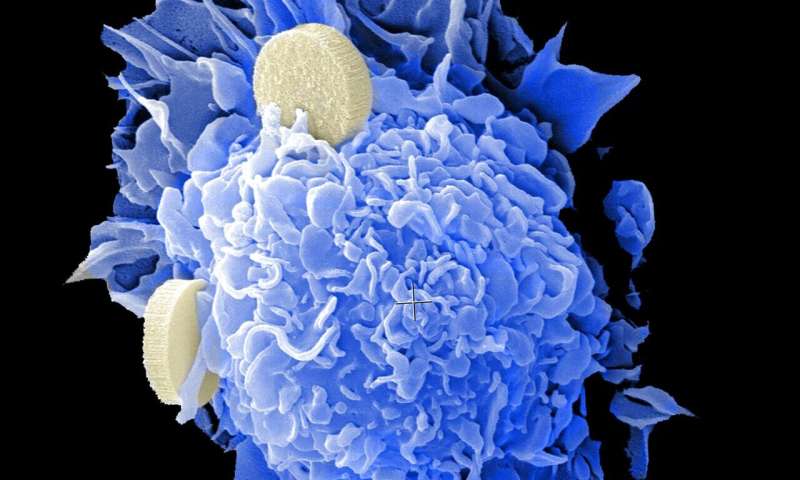Drug combination proves effective in rare peripheral nerve sheath tumours


Malignant tumors of the peripheral nerve are rare but aggressive and very difficult to treat successfully. Now, researchers in the U.S. have shown that a combination of two types of anti-cancer drugs, MEK and SHP2 inhibitors, is effective in targeting the mechanism that drives the cancer’s growth.
Although the work has been carried out in cells and mice, this discovery means that there are immediate implications for improving the treatment and outcomes for patients with this cancer, according to Dr. Jiawan Wang, who will be presenting her findings at the 32th EORTC-NCI-AACR Symposium on Molecular Targets and Cancer Therapeutics, which is taking place online. One of the drugs tested is already approved by the Food and Drug Administration (FDA) in the US, and the other is currently in clinical trials, either as a single agent or in combination with other drugs, for a number of cancers.
Malignant peripheral nerve sheath tumors (MPNST) are cancers of the connective tissue surrounding the nerves, and are classified as sarcomas. Although they occur in approximately 1.5 people per 100,000 of the general population, they account for between 5% and 10% of all soft tissue sarcomas. They are treated with surgery, chemotherapy and sometimes radiotherapy but prognosis is poor overall and the average length of survival among children is 30 months.
“There is an urgent, unmet need for new treatments for this disease,” said Dr. Wang. “Our findings have immediate translational implications and may inform future clinical trials for patients with MPNST.”
Dr. Wang, a postdoctoral research fellow at the Department of Oncology/Pediatric Oncology, Johns Hopkins University School of Medicine, Baltimore, U.S., and her colleagues, led by Dr. Christine Pratilas, also at Johns Hopkins, knew that in the majority of these tumors growth is driven by the loss of a protein called neurofibromin 1 (NF1), which regulates a cell signaling pathway called RAS/MEK/ERK. Neurofibromatosis is a genetic condition in which tumors, normally benign, grow in the nervous system. However, these benign tumors can change to malignant tumors, and therefore people with neurofibromatosis type 1 are at high risk of developing MPNST. Anti-cancer drugs designed to inhibit MEK have had limited effect against MPNST when tested in cells and mice in the lab.
Dr. Wang discovered how MPNST adapts its response to anti-cancer drugs that disrupt the signals that drive its growth. She found that cell surface receptors called receptor tyrosine kinases (RTKs) interacted with the RAS protein, which is involved in cell signaling, to limit the cancer cells’ sensitivity to drugs that inhibit MEK.
“As there are no drugs available that inhibit RAS, we thought that an alternate strategy would be to use a drug against a protein called SHP2, which plays a role in the activation of RAS when RTKs are active, to regulate cell survival and proliferation,” she said.
Dr. Wang investigated the activity of an existing SHP2 inhibitor, SHP099, on MPNST cells in the lab and found that it produced a modest response. However, the combination of the SHP2 inhibitor with a MEK inhibitor worked even better.
“We found that this combination was effective in MPNST that were resistant to MEK inhibition and it also showed efficacy in plexiform neurofibroma, which is an abnormal yet benign tumor that occurs commonly in patients with neurofibromatosis type 1,” she said. “We then confirmed the efficacy of the combination in MPNST in mice. The MEK inhibitor that we tested is trametinib, which is an FDA-approved drug for melanoma, lung and thyroid cancers, and the SHP2 inhibitor, SHP099, is a compound related to another drug, TNO155, which is currently in clinical development as single agent or in combination with other drugs for several cancer types. The low dose combination of trametinib and SHP099 was well tolerated in mice we tested.”
There may be concerns related to treating patients with combinations of SHP2 and MEK inhibitors because of potential adverse side-effects, so studies in patients are needed to evaluate the safety of the combination. However, Dr. Wang believes that side effects expected at high doses of the drugs may be minimized if lower doses of both drugs are used.
“In our work, we used a low-dose treatment schedule of 0.3 mg/kg trametinib and/or 50 mg/kg SHP099 once daily, five days on and two days off, and we did not observe obvious weight loss, despite some hair loss indicating possible skin toxicity in some mice receiving a combination of the two drugs,” she said.
The next step is for the researchers to test the drug combination in a wide range of patient-derived MPNST that have been grafted into mice. If the results are successful, the combination could then move into clinical trials in patients. This means it could be two years before the results from this research could be translated into new and better treatments for patients.
Source: Read Full Article